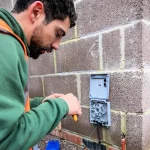BT Scoops £13m Northumberland UK Full Fibre Rollout Contract

The North of Tyne Combined Authority (NTCA), which represents Newcastle, North Tyneside (Tyne and Wear) and Northumberland, has announced that BT have secured the contract to deploy a new gigabit-capable “full fibre” broadband and Ethernet network to help connect 271 public sector sites (council offices, libraries, NHS etc.).
The original proposal for the Northumberland Gigabit Project actually envisaged a much larger project to connect as many as 900 public buildings (here), although it appears as if the final agreement has been scaled-back. Likewise, there’s no mention this time around of the local authorities’ match-funding with the £12m that will be coming from the UK Government’s Local Full Fibre Networks (LFFN) fund.
However, the Council have agreed to put forward a further £932,111 of funding towards the programme, which will be delivered via BT’s Enterprise division (Openreach). The first street works are said to have already begun and, if all goes to plan, then they should be completed by early 2022.
Advertisement
Cllr Nick Oliver said:
“This is an exciting upgrade to our infrastructure in the county, providing rural Northumberland with better connectivity than many city centres.
Work has already begun to bring high-speed, affordable and reliable connectivity to our businesses and residents, which is crucial in maintaining our economic competitiveness and achieving social inclusion, now more than ever.”
Sarah Walker, BT Director for Enterprise, said:
“Our world-class full fibre network will help transform Northumberland’s digital connectivity potential.
We will provide ultrafast broadband speeds that will enable faster and more reliable connections for people across the county. We are pleased to be supporting Northumberland County Council’s digital ambitions and it is among the leading areas in the UK to take advantage of the opportunities full fibre networks will provide.
Digital technology is transforming every element of the way we live. In a world where everyday life and work increasingly depend on technology, digital skills can be the difference between getting ahead, or being left behind.”
The primary focus of this project was previously said to be on improving connectivity to sites in rural areas, which further down the road might also provide a useful platform to help roll-out Gigabit speed broadband ISP connectivity to more homes and businesses. We normally see operator’s like Cityfibre scoop up these anchor tenancy style contracts, but BT have won a few of them too and now they’ve added another one to their belt.
Mark is a professional technology writer, IT consultant and computer engineer from Dorset (England), he also founded ISPreview in 1999 and enjoys analysing the latest telecoms and broadband developments. Find me on X (Twitter), Mastodon, Facebook, BlueSky, Threads.net and Linkedin.
« Cityfibre UK Start Wolverhampton 1Gbps FTTH Broadband Build





















































What is the actual point of having a bidding, 99% of the time it is awarded to BT anyway. It would help speed up the process if there was no bidding.
To meet EU competition and state aid rules
Incorrect. Amongst others, CityFibre and VirginMedia have been successful in winning a number of the LFFN contracts. For example the largest of these (the Manchester project) was won by VirginMedia and Portsmouth was awarded to CityFibre.
Justin, why not finish rural Northumberland? Berwick-upon-tweed is 89%. Do not say vouchers as they offer 1/10 of the volume/value? Questions raised by EFRA Select Committees since 2016 have been avoided. Is it the intention to have BT just hand back the Capital Deferral and leave the work unfinished?
£13m subsidising private circuits where they can already be ordered does little when you would expect local authority buildings to rely less on private circuit based services going forward. Why are private circuits being subsidised?
BT Enterprise is a completely separate entity from Openreach, but the wording in the article seems to suggest otherwise.
In reality, if BT gain money or Open reach gain money or EE gain money, it feeds the same company, so it shouldn’t matter.
Wrong!
While Openreach is a separate company on paper called Openreach Limited, with its own staff and management, its network assets continue to be owned by BT plc for land-contract reasons.
Also, Openreach Limited is wholly owned by BT Group plc, BT plc’s parent holding company.
OFCOM never really followed through with making Openreach a genuine independent company.
Note the word entity, not company or part of the same group…..
Part of the same group they may be, but different board, different accounts, different businesses, different regulation.
The contract is with BT Enterprise, who use Openreach products as well as others including their own to deliver the service. In exactly the same was as BT Consumer provide the domestic internet service using Openreach products.
I thought from the headline that was great news for people in Northumberland, getting a full fibre rollout.
But no its the local government spending those peoples taxes to get themselves better connectivity at work.
That headline is practically ‘click bait’
@Gary I agree with your scepticism about LFFN in urban areas, it just looks like government subsidy for new council networks. But Northumberland is the most sparsely populated county in England and there are lots of small village schools and doctors’ surgeries that will only be on FTTC speeds. OK for admin but not running digital lessons or consultations. If exploited to offer digital public services this can be a big benefit and push fibre nodes further out into rural areas.
I would like to see which towns and villages this funding will be applied to as it could be a great springboard to bring FTTP to areas which would not otherwise receive such services.
Interestingly Openreach seem to have deployed a fair amount of FTTP under their agreement with iNorthumberland to relatively sparsely populated areas. It is not unusual to find farms and properties outside of population hubs such as Hexham and Morpeth with FTTP connections. I suspect this is because there is a reasonable expectation that Openreach will self-invest in those areas and bring FTTP to the masses over the next few years therefore no need to provide additional subsidies.
There can therefore be the somewhat unusual situation where a house in the middle of the countryside has a fabulous connection, whereas those in a town are on a relatively poor FTTC connection. Our house is a few metres away from a FTTC box, but given they are older properties the network was never updated to connect to it. As a result I achieve a max speed of 24mbps up and 2mbps down….bearable, but hardly brilliant.
The B4RN rollout in the Allendale valley is something I look at with great envy!